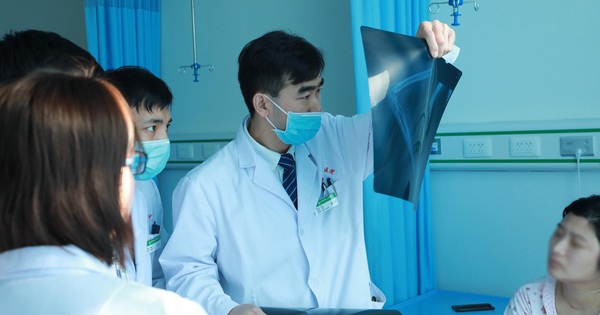Surgery to remove aneurysms for hemodialysis patients
Doctor Tam Anh General Hospital performed surgery to remove an aneurysm the size of the forearm and restore an arteriovenous junction for a hemodialysis patient.
The doctor, Doctor Nguyen Anh Dung, Head of Cardiovascular – Thoracic Surgery, Cardiovascular Center, Tam Anh General Hospital in Ho Chi Minh City said that patient Nguyen Kim Xuan (over 60 years old, District 12, Ho Chi Minh City) was admitted to the hospital. hospital with a 6 cm diameter aneurysm in his forearm. He suffers from chronic renal failure and underwent cyclic hemodialysis 8 years ago via a previously operated vascular (auto-arteriovenous catheter) route.
Through the process of using this vein for dialysis, the vein slowly swells, until it is almost the size of the patient’s forearm. Not only that, this bulge is also infected. “If not treated on time, aneurysms can lead to complications leading to sepsis or endocarditis. In addition, the patient has high blood pressure, so the aneurysm is at risk of rupture, threatening the patient’s life, said Dr Dung.

The aneurysm was the size of the patient’s forearm before surgery. Photo: Tam Anh General Hospital.
Immediately, the doctors conducted a consultation to plan the surgical removal of the aneurysm in the patient. According to Dr Nguyen Anh Dung, the biggest difficulty of this surgery is to treat the damaged aneurysm and restore the arteriovenous junction (AVF) so that the patient can continue cyclic hemodialysis. Therefore, the operation requires an experienced surgeon to handle the segment skillfully, otherwise it will damage the blood vessels and lose the patient’s opportunity for dialysis.
After the surgery, which lasted more than three hours, doctors removed the entire aneurysm, then reattached the healthy blood vessels so the patient could continue on dialysis. Madam Xuan’s health recovered well and was discharged from the hospital a day later.
AVF. vascular conservative management technique
Nguyen Anh Dung That said, a vascular AVF (also known as an AVF bridge) is an arterial bridge that is created in a patient before hemodialysis is performed. AVF aneurysms occur when blood vessels widen in response to increased blood flow, sometimes forming a blood-filled sac. The reason is because the walls of the blood vessels are weak plus the patient has a history of high blood pressure.

Doctor Nguyen Anh Dung (left) and a team of doctors from the Cardiovascular Center of Tam Anh General Hospital in Ho Chi Minh City perform the surgery. Photo: Tam Anh General Hospital.
“About 20% of dialysis patients have aneurysms, depending on how big or small they are. Not all of these aneurysms need to be treated. Small stable aneurysms are often thick-walled, so they don’t need to be treated. can be treated. medically, while continuing to be monitored so that it does not grow,” said Dr. Dung.
However, Dr. Dung further recommends that, with enlarged blood vessels, the risk of infection and rupture is enormous. On the other hand, patients also face life-threatening complications from sepsis or endocarditis (bacteria entering the bloodstream). “So in this case, surgery to remove the aneurysm and AVF revascularization to help the patient continue on dialysis should be done as soon as possible,” said Dr. Dung. Surgery will help remove the entire aneurysm and preserve the vascular segment for the patient.
According to Dr. Nguyen Anh Dung, to prevent complications of AVF aneurysm in hemodialysis patients, patients need to stabilize blood pressure before and during dialysis. Also, after dialysis, just use your finger to gently press the needle removal site for about 10 minutes. The second needle should not be withdrawn until the first puncture has stopped bleeding. After the bleeding stops, cover the area with gauze, do not wrap the bandage around the arm. Remove the gauze after 4-6 hours of dialysis treatment.
Thurs Ha
at Blogtuan.info – Source: vnexpress.net – Read the original article here



